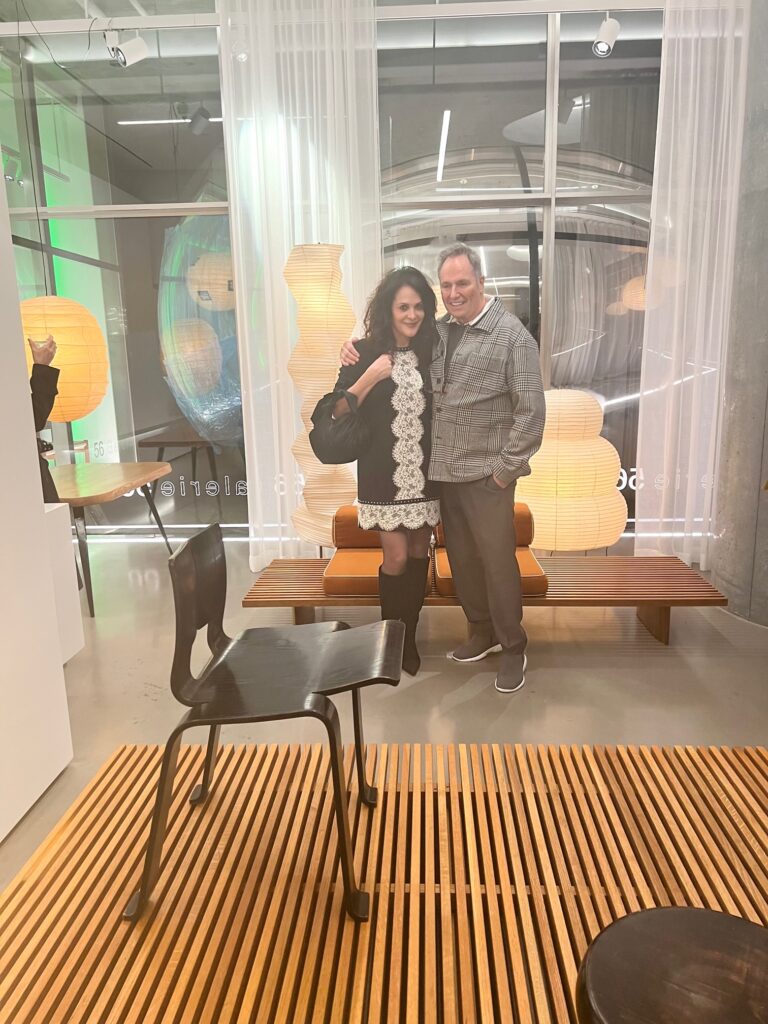
Charlotte Perriand (1903-1999) and Isamu Noguchi (1904-1988), two pillars in the pantheon of modern design, had much in common. Although Perriand was born in Paris and Noguchi in Los Angeles, they were contemporaries whose paths would cross many times. Their love for Japan and the extended periods the two spent there brought them to create design of similar aesthetic sensibilities and would be an immense influence on their own oeuvre. A new exhibition on view at Galerie56 entitled Noguchi to Perriand – East Meets West, comes to reveal the aesthetic and historical connection between the two designers.
When the Second World War began in Europe, Perriand was invited by Japan’s trade ministry to travel to work as a design consultant, advising the Japanese how to devise products for exporting to the West. At first, she was weary on whether or not it was the right time to travel, but eventually decided to make a two-month journey—leaving just days before Germany invaded France. It was the best decision she ever made, because upon arriving to Japan in 1940, she immediately found her own voice. She identified with Japanese cultural ways such as avoiding excess, living closer to the ground on tatami mats, and the flexibility of the interior space. This helped her develop a passion for traditional Japanese house materials like wood, straw, and rice paper. When Perriand made a pilgrimage trip to Kyoto’s Imperial Villa of Katsura, like many other European modernists before her, she “approached it with something like religious awe,” as she recalls in her memoir A Life of Creation. The Japanese experience had a profound impact on Perriand, and upon returning to France her designs never looked the same—now infused with the Japanese story. Even her iconic Nuage bookshelf was born out of the cloud forms she saw in the skies of Katsura.
Nine years after Perriand left Japan, Noguchi—who maintained studios both in Japan and New York—arrived in the town of Gifu and discovered the allure of paper lanterns: Japanese traditional lights called chochin that have been utilized since the 9th century. He entered into a partnership with Gifu’s producer Ozeki & Co. Ltd. and designed modernist lights that he named Akari, which were handcrafted in bamboo ribbing and washi paper. In fact, Noguchi has been credited with revitalizing the traditional paper lanterns and opened a showroom in Tokyo where he displayed the colorless, light, dreamlike sculptural Akari lamps, which he also exhibited throughout the 1950s. Perriand was so impressed with those humble lamps that in 1951, the year Noguchi started to produce them, she bought one for her newly renovated home on rue Las Cases in Paris. Seen in a period photograph, it complemented her own furniture which she created for her own home before leaving for Japan a decade earlier.
The paths of these two would cross when Perriand’s furniture and Noguchi’s Akari were both represented by Galerie Steph Simon, the key Parisian platform on boulevard Saint-Germain. The successful juxtaposition of Perriand’s simple furniture in wood founded on Japanese principles and Noguchi’s Akari, as seen in many photographs of the exhibitions held at the gallery, attracted such celebrities as Cesar, Brigitte Bardot, Gérard Philippe, and Vadim. Now, the two are coming together again at Galerie56, and the space could not look better: the Akari 21N floor lamp and Akari 30P ceiling lamp, along with Perriand’s famed Shadow chair—which she first created for an exhibition in Japan in 1956.
The exhibition is curated by the architect Lee F. Mindel at his new Galerie56 in partnership with Francois Laffanour of Parisian Galerie Downtown. The new gallery is situated at the base of one of the most extraordinary residential glass towers of New York designed by Herzog and de Meuron, nicknamed “Jenga Tower.” The focus of the highly anticipated space is pop-up shows by some of the world’s leading design galleries. Mindel is the real thing; co-founder of the award-winning architecture firm SheltonMindel, he has made his name by creating dazzling spaces that reflect his brilliance, knowledge in historical design, signature spatial expression, and connoisseurship. ‘He has the eye of a curator, the heart of a poet, and the charisma of a star actor,’ I noted when he participated in the series ‘Interior Design: The Legends.‘ Writer, photographer, collector, culture consumer, traveler, and expert, Mindel is known as the grand gentleman of the international design world. His gallery is fresh and exciting, and judging from this second show at the gallery, I foresee a brilliant future.










In a nutshell. — excellent.